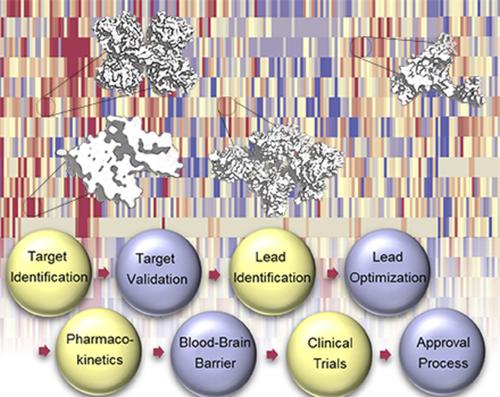当前位置:
X-MOL 学术
›
Pharmacol. Rev.
›
论文详情
Our official English website, www.x-mol.net, welcomes your
feedback! (Note: you will need to create a separate account there.)
Current Challenges and Opportunities in Treating Glioblastoma
Pharmacological Reviews ( IF 19.3 ) Pub Date : 2018-07-01 , DOI: 10.1124/pr.117.014944 Andrea Shergalis 1 , Armand Bankhead 1 , Urarika Luesakul 1 , Nongnuj Muangsin 1 , Nouri Neamati 2
Pharmacological Reviews ( IF 19.3 ) Pub Date : 2018-07-01 , DOI: 10.1124/pr.117.014944 Andrea Shergalis 1 , Armand Bankhead 1 , Urarika Luesakul 1 , Nongnuj Muangsin 1 , Nouri Neamati 2
Affiliation

|
Glioblastoma multiforme (GBM), the most common and aggressive primary brain tumor, has a high mortality rate despite extensive efforts to develop new treatments. GBM exhibits both intra- and intertumor heterogeneity, lending to resistance and eventual tumor recurrence. Large-scale genomic and proteomic analysis of GBM tumors has uncovered potential drug targets. Effective and “druggable” targets must be validated to embark on a robust medicinal chemistry campaign culminating in the discovery of clinical candidates. Here, we review recent developments in GBM drug discovery and delivery. To identify GBM drug targets, we performed extensive bioinformatics analysis using data from The Cancer Genome Atlas project. We discovered 20 genes, BOC, CLEC4GP1, ELOVL6, EREG, ESR2, FDCSP, FURIN, FUT8-AS1, GZMB, IRX3, LITAF, NDEL1, NKX3-1, PODNL1, PTPRN, QSOX1, SEMA4F, TH, VEGFC, and C20orf166AS1 that are overexpressed in a subpopulation of GBM patients and correlate with poor survival outcomes. Importantly, nine of these genes exhibit higher expression in GBM versus low-grade glioma and may be involved in disease progression. In this review, we discuss these proteins in the context of GBM disease progression. We also conducted computational multi-parameter optimization to assess the blood-brain barrier (BBB) permeability of small molecules in clinical trials for GBM treatment. Drug delivery in the context of GBM is particularly challenging because the BBB hinders small molecule transport. Therefore, we discuss novel drug delivery methods, including nanoparticles and prodrugs. Given the aggressive nature of GBM and the complexity of targeting the central nervous system, effective treatment options are a major unmet medical need. Identification and validation of biomarkers and drug targets associated with GBM disease progression present an exciting opportunity to improve treatment of this devastating disease.
中文翻译:

当前治疗胶质母细胞瘤的挑战和机遇
多形性胶质母细胞瘤(GBM)是最常见和最具侵袭性的原发性脑肿瘤,尽管人们努力开发新的治疗方法,但其死亡率仍然很高。 GBM 表现出肿瘤内和肿瘤间的异质性,导致耐药性和最终肿瘤复发。 GBM 肿瘤的大规模基因组和蛋白质组分析发现了潜在的药物靶点。必须验证有效且“可成药”的目标,才能开展强有力的药物化学活动,最终发现临床候选药物。在这里,我们回顾 GBM 药物发现和递送的最新进展。为了确定 GBM 药物靶点,我们使用癌症基因组图谱项目的数据进行了广泛的生物信息学分析。我们发现了 20 个基因: BOC 、 CLEC4GP1 、 ELOVL6 、 EREG 、 ESR2 、 FDCSP 、 FURIN 、 FUT8-AS1 、 GZMB 、 IRX3 、 LITAF 、 NDEL1 、 NKX3-1 、 PODNL1 、 PTPRN 、 QSOX1 、 SEMA4F 、 TH 、 VEGFC和C20orf166AS 1那个在 GBM 患者亚群中过度表达,并与不良生存结果相关。重要的是,其中九个基因在 GBM 中表现出比低级别神经胶质瘤更高的表达,并且可能与疾病进展有关。在这篇综述中,我们在 GBM 疾病进展的背景下讨论这些蛋白质。我们还进行了计算多参数优化,以评估 GBM 治疗临床试验中小分子的血脑屏障 (BBB) 渗透性。 GBM 中的药物输送尤其具有挑战性,因为血脑屏障阻碍小分子转运。 因此,我们讨论新型药物递送方法,包括纳米颗粒和前药。鉴于 GBM 的侵袭性和针对中枢神经系统的复杂性,有效的治疗方案是一个未满足的主要医疗需求。与 GBM 疾病进展相关的生物标志物和药物靶标的鉴定和验证为改善这种破坏性疾病的治疗提供了令人兴奋的机会。
更新日期:2018-07-14
中文翻译:

当前治疗胶质母细胞瘤的挑战和机遇
多形性胶质母细胞瘤(GBM)是最常见和最具侵袭性的原发性脑肿瘤,尽管人们努力开发新的治疗方法,但其死亡率仍然很高。 GBM 表现出肿瘤内和肿瘤间的异质性,导致耐药性和最终肿瘤复发。 GBM 肿瘤的大规模基因组和蛋白质组分析发现了潜在的药物靶点。必须验证有效且“可成药”的目标,才能开展强有力的药物化学活动,最终发现临床候选药物。在这里,我们回顾 GBM 药物发现和递送的最新进展。为了确定 GBM 药物靶点,我们使用癌症基因组图谱项目的数据进行了广泛的生物信息学分析。我们发现了 20 个基因: BOC 、 CLEC4GP1 、 ELOVL6 、 EREG 、 ESR2 、 FDCSP 、 FURIN 、 FUT8-AS1 、 GZMB 、 IRX3 、 LITAF 、 NDEL1 、 NKX3-1 、 PODNL1 、 PTPRN 、 QSOX1 、 SEMA4F 、 TH 、 VEGFC和C20orf166AS 1那个在 GBM 患者亚群中过度表达,并与不良生存结果相关。重要的是,其中九个基因在 GBM 中表现出比低级别神经胶质瘤更高的表达,并且可能与疾病进展有关。在这篇综述中,我们在 GBM 疾病进展的背景下讨论这些蛋白质。我们还进行了计算多参数优化,以评估 GBM 治疗临床试验中小分子的血脑屏障 (BBB) 渗透性。 GBM 中的药物输送尤其具有挑战性,因为血脑屏障阻碍小分子转运。 因此,我们讨论新型药物递送方法,包括纳米颗粒和前药。鉴于 GBM 的侵袭性和针对中枢神经系统的复杂性,有效的治疗方案是一个未满足的主要医疗需求。与 GBM 疾病进展相关的生物标志物和药物靶标的鉴定和验证为改善这种破坏性疾病的治疗提供了令人兴奋的机会。











































 京公网安备 11010802027423号
京公网安备 11010802027423号